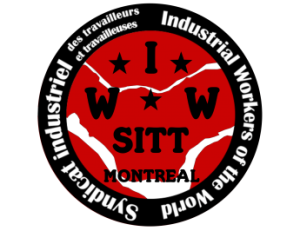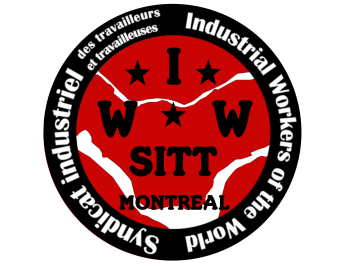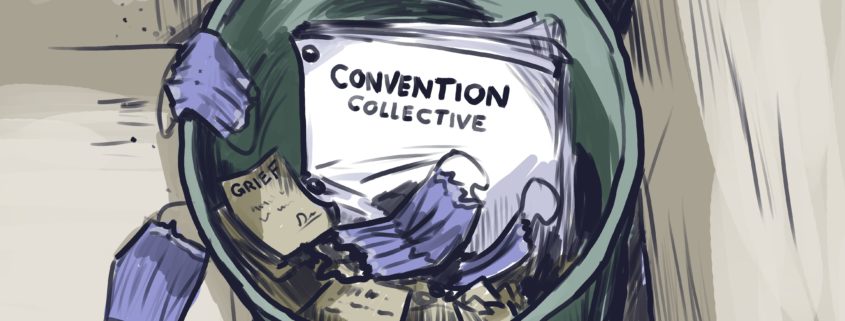Grievances Suspended, health care workers turn to direct action
An anonymous source describes the direct actions employed, during the public health crisis in Ontario, by long-term care home workers now that grievances are on hold.
The 17 mars, Premier Doug Ford has declared a state of emergency in Ontario. For most people, it was now forbidden to meet in groups. Shopping malls and public places have been closed, and workers have been forced to stay home trying to figure out how to feed themselves and pay the bills ; but for health personnel, it was something else.
The declaration of emergency has suspended a large part of the collective agreements in the health sector. For the employer, this means that all the measures restricting working hours, assignments, workplaces and tasks, are no longer in effect during the pandemic. All holidays and vacations have been canceled, to the point where – when asked – employers said they now believe they have the right, under the declaration of emergency, to cancel maternity leave if they so wish, while hoping that it would not be the case.
The usual mechanisms that unions use to resolve workplace issues have suffered a lot of collateral damage. Accelerated Arbitration, where a union can ask the Ontario Labor Relations Board to appoint an arbitrator and hold a hearing within the 30 days, is not currently used. The CRTO routinely fails to respond to these requests, so the layout may as well not exist. In normal time, an order for the execution of dangerous work can be resolved by a refusal, and by contacting the Ministry of Labor to investigate and decide on the safety of the work required. Since the COVID-19 crisis, this ministry first contacts the management, then talk to the workers, and ends by publicly stating that there is no problem. Employers just ignore grievances because they know they can. Union representatives cannot visit the workplace, because they have been classified as “non-essential visitors”.
In some workplaces, it's disastrous. Without a visit from a union representative and without grievance meetings, some workers feel that the union does not exist right now. Managers take the opportunity to tell employees that unions cannot help them and that they will only be relevant again after the pandemic. Members call their union representatives begging them to act but nothing happens as the usual methods are suspended.
For other workplaces, however, it is a chance to progress by pushing even further the gains made in the past. These units, even if they also use the grievance procedure, don't just rely on her to get things done. Some of these units have a long history of direct action, others flex their muscles for the first time… But all have improved their working conditions !
I would like to share two of their stories. One is an already combative unit ; the other is a unit where they begin to realize that the struggle pays. Both employers will remain anonymous..
Planning and Assignment
The first unit is a long-term care home that practices coordinated action to achieve gains. In the past, they mobilized residents and their families to fight against unpopular management decisions such as contracting out. Long before COVID, they were already banding together regularly to collectively refuse to allow the employer to replace full-time positions with additional part-time shifts. In a number of cases, when an employee has been unfairly suspended, they collectively refused to agree to fill the suspended position to send a message to the employer. Sometimes, this. suspended employee was even brought back to work before the end of the suspension in order to maintain the workforce in place.
Workers at this nursing home continue to make gains despite the current suspension of part of their collective agreement. One of the elements of the emergency declaration is an order that all health care workers can only work for one employer. When a manager tried to take advantage of the declaration of emergency to implement a schedule of 12 extremely unpopular hours, more than half of the employees in this unit have banded together and told their manager that if this happens, they would go to work in another care facility, forcing the manager to reconsider his decision.
In another case, of workers were displaced in the establishment during their shift, sent from a non-COVID unit to a unit dealing with the virus, then returned to the non-COVID unit during the same shift. After a brief discussion with management, they were threatened with termination for quitting their job if they refused to return to a non-COVID unit during the same shift. After discussing the situation between them, they went back to their manager with an ultimatum : either movement between units stops immediately, or each worker discharged to a non-COVID unit during the same shift calls Public Health and reports COVID exposure. They knew very well that Public Health would quarantine them for 14 days before allowing them to return to work, which would cause a huge problem – due to understaffing – for the manager. By working together, they were able to achieve their goals despite the dismantling of the grievance procedure.
Individual protection equipment (EPI)
In another unit with no direct action history, workers begin to realize their power. When the emergency order was issued, managers told shop stewards that the union was no longer relevant and would only be after the pandemic. Grievances were filed and ignored. Shop stewards approached management to discuss issues, and they were told to go away and come back after the pandemic. Not wanting to wait to deal with these important and urgent issues, these employees needed another plan. Meetings have taken place (virtually, of course) and an action plan has been agreed.
The first point to be addressed for these workers was access to PPE. Chief Medical Officer of Public Health has ordered PPE readily available, but their employer was putting a spoke in the wheels. A one-procedure mask was provided when they arrived at work, and if they needed another, or an N95 mask, or blouses, or gloves, they had to go to a manager. The director asked a lot of questions so as not to grant their request.. Several times, they were told that an N95 mask costs 7 $, which should be the last security concern. It turns out that the evening manager, tasked with guarding and reluctantly distributing PPE, was not herself a health worker, but was working in an auxiliary support role. A night, two employees approached and asked for additional PPE, what was refused. One of the employees gave her a copy of one of the directives from the Chief Medical Officer of Public Health, which specifically excluded all non-essential visitors and workers from long-term care homes. The manager asked how this was relevant, and the other employee said: “We are three here, but only two of us are essential employees. You can do it in two ways : either you give the PPE to any employee who asks for it ; either we send you home now by calling Public Health if you refuse to leave. The manager called (and woke up) its own director, and the manager showed up on the scene to try to dissuade the workers from the PPE they had requested, but they stood firm. Finally, the management relented and the next morning, a new directive has been sent to all workers informing them that “as a precautionary measure”, PPE would be distributed free of charge.
Another lever that workers use is the media. Their place of work was recently highlighted in the news, and it's not positive. The direction, who normally tries to control what the media can say about this company, is overtaken by events. Employees regularly use it to challenge management decisions regarding staffing and quarantine policies. When management implements a change, workers have a virtual meeting to answer a question: is it stupid now or will it be stupid at six o'clock, to the news? This phrase caught on, and managers don't know how to respond.
While some workers speak openly to the media, many others are more reluctant. So, a spokesperson who is not employed by the company has been selected to brief the media on what is happening inside the healthcare home. In the break room, there is a television which is usually tuned to one of the local news channels. A few weeks ago, a manager blocked all news channels out of spite. To work around this problem, workers organize Facebook viewings during their breaks, seated six feet apart in the dining room, on their cell phone, the volume clearly audible. During this pandemic, management began alluding to discipline to – as they put it – “restore order” to work, but she can't do much without putting herself in a worse situation than she already is.
This unit realizes the power of direct action and begins to understand its power in the workplace. New leaders begin to emerge. Some “official” representatives fall into rout, while others play a leading role in collective direct action at work.
Lessons
The conclusion that can be drawn is simple. Collective agreements, grievances, arbitrations and formal union channels can be used to mitigate some of the harm a bad employer can do to workers, but they can't fix everything. Not only are they flawed by design, but they can be suspended or rendered ineffective very easily by the government in place.
Grievances can be delayed but not direct class action. Collective agreements can be suspended, temporarily, as in this case ; or even permanently as has happened throughout history ; but direct collective action is always in the present. Workplaces where workers have erected a rampart, or have a proven history of collective direct action, are faring much better during the pandemic than those who don't.





Leave a Reply
Want to join the discussion?Feel free to contribute!